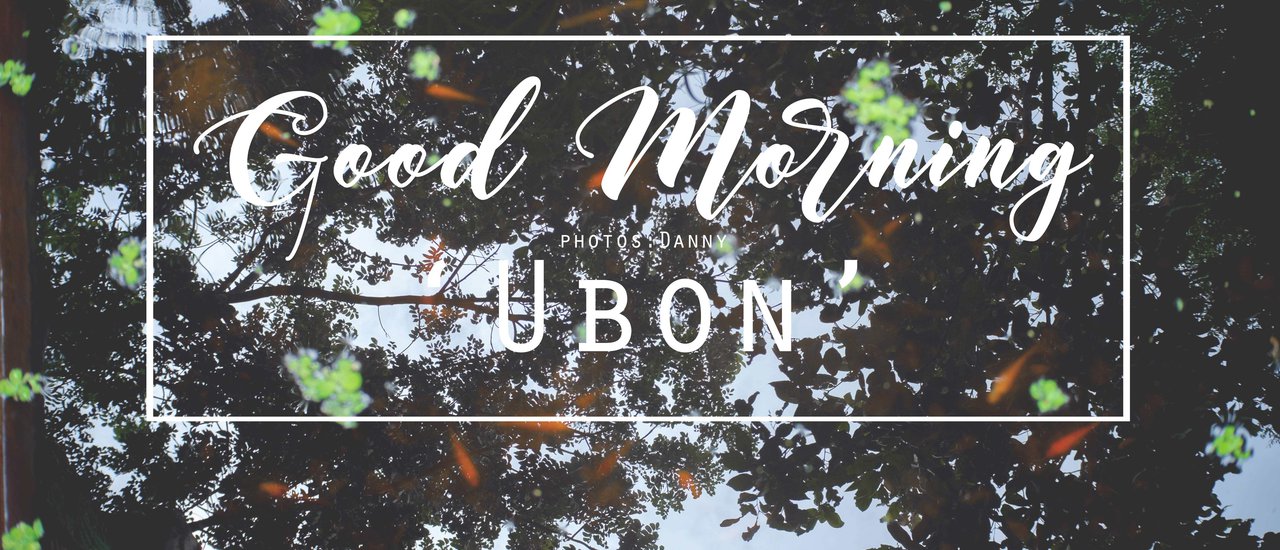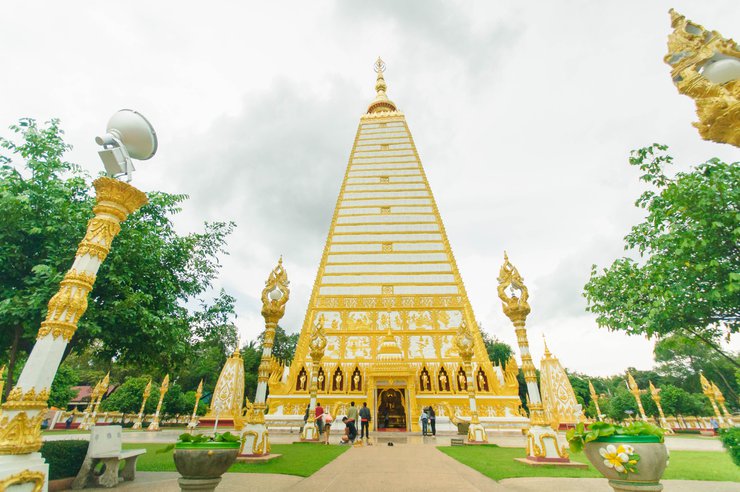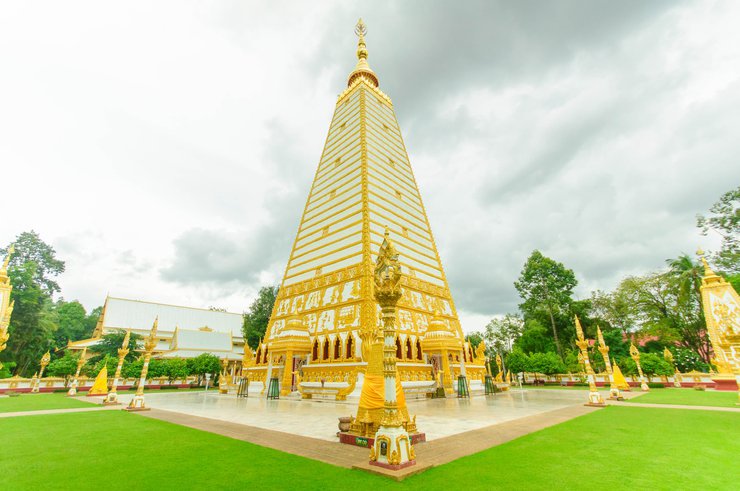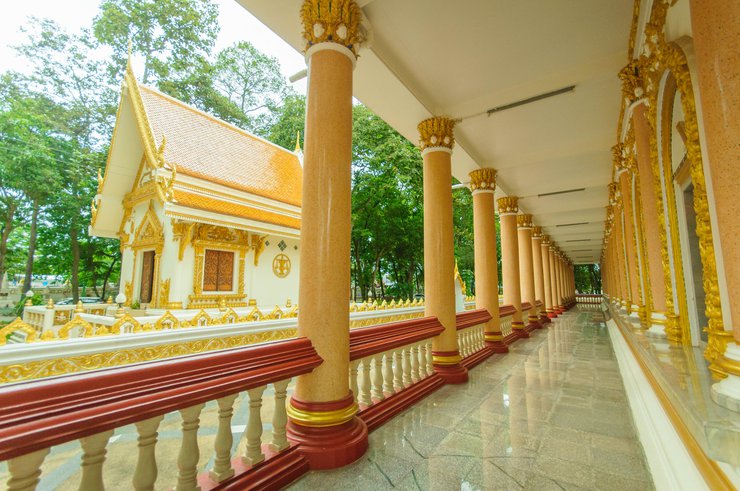Greetings to all our esteemed readers, both those who have been following us consistently and those who have dropped by to say hello and engage in our regular Q&A sessions. We extend our heartfelt gratitude to each and every one of you. ^ ^
Encountering Serenity: Exploring the Temples of Ubon Ratchathani
During a recent period of relaxation, I embarked on a photographic journey to capture the serene beauty of temples in Ubon Ratchathani, Thailand. Among these sacred spaces, Wat Phra That Nong Bua stands out as a testament to the region's rich cultural heritage.
Wat Phra That Nong Bua: A Significant Temple in Ubon Ratchathani
Wat Phra That Nong Bua is a significant temple in Ubon Ratchathani province, Thailand. It is a third-class royal temple of the Thammayut Nikaya sect, located approximately 3 kilometers north of the provincial hall on Tharmwithi Road, branching off from Chayangkun Road towards the west for about 500 meters. Established in 1955, the temple occupies an area of 50 rai, 1 ngan, and 19 square wa.
The temple boasts several notable architectural features, including the Phra That Si Maha Phothi stupa. This stupa was constructed to commemorate the 25th Buddhist Century in 1957. Its design incorporates elements of both the Dvaravati and Srivijaya styles, showcasing a unique blend of architectural influences.
Wat Phra That Nong Bua plays a vital role in the religious and cultural landscape of Ubon Ratchathani. It serves as a center for Buddhist teachings and practices, attracting devotees from across the region. The temple also hosts various religious ceremonies and festivals throughout the year, further strengthening its connection to the local community.
Source: http://guideubon.com/news/view.php?t=18&sid=20&did=8

The Sri Maha Bodhi Chedi is a replica of the Mahabodhi Temple in Bodh Gaya, India. It houses a relic of the Buddha. The chedi is surrounded by a glass wall, with four smaller chedis at each corner. There are four entrances to the chedi, one on each side.

The original stupa measured 5 meters wide and approximately 17 meters high. The current stupa, which was built around the original one, is much larger. Its square base measures 17 meters wide and 56 meters high. It was completed in 1969. (Source: http://guideubon.com/news/view.php?t=18&s_id=20&d_id=8)
Inside the Sri Maha Bodhi Chedi

Behind the main stupa is the Sala Kan Parien, which is used for religious ceremonies and traditions. The lay people's group will be gathered behind, which is a hut built in a natural environment, which is an open forest. As for the nuns' huts, they will be separated outside the temple.

The exterior of the prayer hall


Every day, Buddhist devotees visit the temple to pay homage to the sacred relics, especially during holidays or religious festivals.
It is considered one of the most important temples in Ubon Ratchathani province. If you have free time or business in the city, you can visit the temple to pay respect to the relics.
Wat Thung Si Mueang
Wat Tung Sri Muang is located at 95 Luang Road, Nai Mueang Subdistrict, Mueang District, Ubon Ratchathani Province. It is situated on the east side of Tung Sri Muang, near government offices such as the post office, Ubon Ratchathani City Municipality office, and Ubon Ratchathani Kindergarten School.

It covers an area of 19 rai, 2 ngan and 23 square wah. It is believed to have been built in 1813 during the reign of King Phra Phutthaloetla Naphalai, Rama II. Source: http://www.dhammathai.org/watthai/northeast/watthoongsrimuang.php
Originally, I planned to visit Wat Pa Yai, but I couldn't find a suitable parking space. Actually, there were parking spaces available, but I'm afraid of tight spaces. Haha. Since it was already late morning, the parking lot in front of the temple was full. So, I changed my plan to Wat Tung Sri Mueang instead. The highlight of this temple is undoubtedly the **waterside library pavilion**. It serves as a repository for the Tripitaka, Buddhist scriptures, local philosophy, and various other texts. Most of the texts are inscribed on palm leaves in the Dhamma script and on mulberry paper scrolls. The pavilion protects the texts from drying out, becoming brittle, and being damaged by termites.


References: http://www.dhammathai.org/watthai/northeast/watthoongsrimuang.php
There are also many important sacred places, such as the Ubosot or the Phra Phutthabat Hall, the Phra Phutthabat replica, the Phra Chao Yai Si Mueang, and the Sala Kan Parian of Wat Thung Si Mueang. When I arrived at the temple, it started to rain heavily. There are still many important places in the temple that I didn't capture. I apologize to the readers. Let's keep it as a surprise for you to see for yourselves. ^ ^

The journey is not difficult. Wat Tung Sri Mueang is located on the east side of Tung Sri Mueang, near government offices such as the post office, Ubon Ratchathani City Hall, Ubon Ratchathani Kindergarten School, or opposite Wat Mani Wanaram (Wat Pa Noi).
The Wat Mahawanaram, originally named Wat Pa Luang Mani Chotisri Sawat, also known as Wat Pa Yai, is a royal temple and an ancient landmark of Ubon Ratchathani province. It is located on Sapphasit Road in Nai Mueang Subdistrict, Mueang Ubon Ratchathani District, Ubon Ratchathani Province.
In 1941, the temple was renamed Wat Mahawan, or Wat Pa Yai, and later changed again to the more popular name Wat Mahawanaram. The meaning of the temple's name remains the same, meaning "great forest." Source: https://en.wikipedia.org/wiki/Wat_Mahawanaram

The second day of my temple visit, this time I rushed to the temple by car. I arrived at the temple around 8:30 am. I parked my car on the other side of the temple, opposite the Sapphasit Hospital, and walked a short distance to the temple. There weren't many people yet, maybe because of the weather, but I like it this way, it's not hot. ^ ^
The Mahawanaram Temple, also known as the Pa Yai Temple, is home to the revered Phra Chao Yai Inthapeng statue. This impressive Lao-style Buddha image, crafted from brick and mortar and adorned with gold leaf, stands in the Marawijai posture, measuring approximately 3 meters wide and 5 meters tall from the base to the top of the flame-like finial. According to an inscription embedded in the pedestal behind the main Buddha statue, the Mahawanaram Temple was constructed around 1820 by Phra Prom Worarat Suriyawong, the second lord of the city. A year later, Phra Maha Ratcha Kru Soralatthamwongsa, the abbot, and his disciples created the Phra Chao Yai Inthapeng statue, which has become a revered symbol of the Ubon Ratchathani province and surrounding areas. Source: http://guideubon.com/news/view.php?t=18&s_id=55&d_id=55

For those who wish to make merit but have not prepared flowers or offerings, there are flowers, incense candles, five-colored threads, etc. available near the Sala for you to make offerings.

Note: The original text is empty. There is nothing to translate.
Daily alms offering on one's birthday

Gilding the Nimi Buddha Image

After a long walk around the temple, I started to feel hot. Not because of the heat of the temple, but because the sky started to clear, and the sun was shining brightly. The rain, as if knowing its duty, fell in the morning, stopped in the afternoon, and then fell again when people got off work. Haha.
For those who have never paid their respects to Luang Pho Inแปลง or are looking for a place to relax their minds and make merit near their home, I recommend visiting Wat Mahawanaram. ^ ^
Wat Buraparam
Wat Burapha Ram
Wat Burapha Ram is located in Tambon Nai Mueang, Mueang District, Ubon Ratchathani Province. Originally, Wat Burapha was located in Ban Saen To, Moo 6, Tambon Pathum, Mueang District, Ubon Ratchathani Province. In 1982, the municipality expanded the Ubon Ratchathani Municipality, and Wat Burapha became part of the Ubon Ratchathani Municipality.
The history of Wat Burapha is not clearly documented, and information is primarily based on oral accounts from elders. According to these accounts, the land where the temple now stands was originally a sparse forest known as "song seng" in the Isan dialect, meaning "open forest." The area was sparsely populated and served as a suitable location for meditation practice. Luang Pu Tha Si and Luang Pu Saen resided there during this period, when it was merely a hermitage.
In 1915, Luang Pu Mun Bhuridatta, upon hearing of the hermitage, traveled from Wat Boromnivas in Bangkok to become a disciple and practice meditation at Wat Burapha. Subsequently, when the Royal Commissioner of the Treasury, Prince Sarprasitphisansuk, donated funds and land for the construction of Wat Burapha, it became a center for the Vipassana meditation lineage. Renowned monks and meditation masters from across the country have since visited the temple to practice meditation.
Reference: http://place.thai-tour.com/ubonratchathani/mueangubonratchathani/16
In actuality, I stumbled upon Wat Burapha by chance. My initial destination was Wat Tai, but alas, the road behind it was closed. Despite being a native of Ubon, I drove around in circles for several rounds before giving up. As I was about to turn back, I drove along a side street until I reached an unknown location. I'm not exaggerating; even as I write this, I can't recall the exact spot. All I remember is stopping my car in front of the temple's main gate.

I parked my car outside and walked into the temple. All I could think about was why I was there. I was hungry and swatting at mosquitoes the whole time. Haha! As I looked around the temple, I felt a little scared because some places forbid photography. People in the temple were looking at me strangely, and I thought to myself that maybe I should just go back. There probably wasn't anything interesting to see. Just as I turned around, I came face-to-face with a large, traditional Thai-style kuti. My feeling at that moment was amazing! I didn't know what was inside, but my eyes couldn't tear themselves away from what I saw. I wondered if the monk would let me take pictures. I decided to ask him if I could take pictures of the outside. (I was still a little worried that he might say no.)

Outside area

As I was enjoying taking pictures outside, I heard a voice from behind me, "You can go take pictures above the kuti." Oh, it was like the voice of heaven at that moment. I quickly bowed and thanked the monk. Without hesitation, I rushed inside. Without paying attention, I slipped and almost hit my head on the floor. Oh, how pathetic I felt! I had to calm myself down for a while, then I put my hands together and prayed to the sacred things, and then I walked slowly and carefully.

The interior of the hut was serene and tranquil, filled with the gentle sounds of a boiling kettle and a small fan. The lush greenery surrounding the hut created a peaceful atmosphere. The beauty of the surroundings made it difficult to choose the perfect angle for a photograph, as every corner seemed equally captivating.

The scene reminded me of a historical drama set in a nobleman's house.


I spent most of my time photographing the traditional Thai houses, forgetting that there were many other important places in the temple, such as the **ancient viharn and the twin libraries**. I only found out about them later when I researched the temple's history. If I had been more patient and walked around the entire temple, I wouldn't have missed them. As the monks say, we should always be mindful. I invite you, the reader, to visit the temple and take some photos to share with us.

Wat Tai Phra Chao Yai Ong Tue
Wat Tai Phra Chao Yai Ong Tue (Wat Tai Thaing)
Wat Tai Phra Chao Yai Ong Tue, also known as Wat Tai, is a Buddhist temple located at 2 Phramarat Road, Nai Mueang Subdistrict, Mueang Ubon Ratchathani District. The temple covers an area of 9 rai, 40 square wa, and is situated near the eastern bank of the Mun River. Nearby landmarks include the Provincial Electricity Authority Region 2, Sector 2 Ubon Ratchathani and the Burapha Ubon Municipal School.
Source: http://www.touronthai.com/วัดใต้พระเจ้าใหญ่องค์ตื้อ-62000048.html

The History of the Big Buddha Statue "Phra Chao Yai Ong Tue"
The Big Buddha Statue "Phra Chao Yai Ong Tue" (เมตตรัยสัทโธ)
The Majestic Buddha of Wat Tai: A Historical Treasure
The principal Buddha image enshrined within the main ordination hall of Wat Tai, known as Phra Chao Yai Ong Tue, is a magnificent bronze statue in the Mara-Vijaya posture. Measuring 51 inches in lap width and 85 inches in height (including the base), this revered image is widely considered one of the most beautiful Buddha statues in Thailand and the northeastern region.
Phra Chao Yai Ong Tue is believed to be one of five such statues created during the reign of King Chaiya Chettha of Vientiane. Originally enshrined on a simple pedestal within the old ordination hall, the statue was exposed to the elements for an extended period after the hall deteriorated. This prolonged exposure resulted in cracks and flaking on the surface of the image.
According to local lore passed down through generations, the statue was once covered in a thick layer of plaster made from a mixture of tree bark, crushed rubber, powdered brick, and precious metals such as gold, silver, and bronze. This plaster was applied using a special technique involving tea and lacquer, followed by gilding. The purpose of this elaborate process was to conceal the true value of the statue, as it was believed to be made of solid gold. Fearing theft by enemies, the local monks disguised the image and abandoned the temple for 200 years.
Source: http://www.touronthai.com/วัดใต้พระเจ้าใหญ่องค์ตื้อ-62000048.html

Unfortunately, I was unable to pay my respects to Luang Pho this time, who is enshrined in the ordination hall. I could only take pictures of the outside of the temple. I will find an opportunity to pay my respects to him next time.

The atmosphere inside the temple.

The temple houses numerous statues of Buddha and deities. This image depicts Vessavana.

Along the walkway beside the ordination hall


There are many more sacred and interesting places within the temple. I haven't even walked around the whole place yet. ^ ^

Paying respects before leaving. 🙏
Wat Suwannaram Worawihan
Note: The original text includes an emoji and a horizontal rule, which have been preserved in the translation.
Wat Suwannaram was built during the reign of King Rama IV, starting in 1850 and completed in 1853. King Rama IV bestowed the name "Wat Suwannaram," which means "temple with a suitable location as a good port."
Reference: http://guideubon.com/news/view.php?t=18&s_id=24&d_id=4

The original ordination hall of Wat Supapatraram Worawihan was built with the personal funds of King Rama IV. The original ordination hall was 11 wa 2 sok long and 8 wa wide. The pillars were made of wood, the walls were made of brick, and the roof was in two tiers and covered with wooden tiles. The gable ends were decorated with glass, and the eastern gable end was carved with a vine pattern, while the western gable end was carved with a flower pattern. The floor was made of earth and covered with terracotta tiles. The old ordination hall was later renovated, and the construction was completed in 1936 at a cost of approximately 70,000 baht.
I arrived at Wat Supapatnaram around noon. The parking lot was full, so I decided to park next to another car (which is not a good practice, so please don't follow my example). Haha, the sun was getting really hot, so I thought I wouldn't stay long. It wouldn't be a problem if someone needed to leave, I could just move my car.
This time, I did not forget to pay my respects to the principal Buddha image in the ordination hall first. The ordination hall was very cool and comfortable. I almost fell asleep myself.

Inside the ordination hall

After paying respects at the temple, we went to feed the fish. Oh, and the pigeons too, or they'll get upset.

It is lunchtime, so it is no surprise to see students running around and playing happily.

I couldn't help but join in their fun, and it made me wish I could be a child again. ^ ^

Wat Su Pattana Ram is another interesting temple in Ubon Ratchathani province. If you have time or are doing business in the city, you can stop by to pay respects and make merit.
Wat Su Pattana Ram Worawihan is located on Wat Su Pattana Road, Mueang District, Ubon Ratchathani Province (on the banks of the Mun River, which flows through the southern part of Ubon Ratchathani city) near the Ubon Ratchathani Vocational College.
Wat Nong Pa Pong
Wat Nong Pah Pong: A Forest Monastery with Global Reach
Wat Nong Pah Pong, a prominent forest monastery in the lineage of the Ajahn Chah tradition, was established in 1954 by Venerable Phra Bodhiñāṇa Thera (Luang Pu Chah Subhaddo). Officially recognized in 1974, the monastery is situated in Ban Phong Sawang, Ubon Ratchathani Province, Thailand.
Wat Nong Pah Pong has become a renowned center for Vipassana meditation, attracting practitioners from around the world. Its influence has led to the establishment of numerous branch monasteries both within Thailand and internationally. This expansion is a testament to the dedication of Luang Pu Chah's disciples, who continue to propagate his teachings and practices.

The Birth of Wat Nong Pah Pong
Wat Nong Pah Pong was established on March 8, 1954, corresponding to the fourth waning day of the fourth lunar month in the year of the Goat. This marked the arrival of Luang Pu Cha and his disciples at the dense Nong Pah Pong forest, located approximately 2-3 kilometers from Luang Pu's birthplace, Ban Ko. On that day, the group of ascetics camped by a pond at the edge of the forest.
Source: https://th.wikipedia.org/wiki/วัดหนองป่าพง

Guidelines for Conduct Within the Temple

On the third day of my temple visit, I arrived at 8:00 am as usual. It only took a short drive from the city center. I parked my car at the market outside, fearing that there might not be any parking space inside or that I might disturb the temple. However, it turned out that parking inside the temple was allowed. Moreover, if you arrive early in the morning, you can easily find a parking spot. The parking lot inside the temple is quite spacious.

On the third day, I'm in no rush. The past two days have been a blur, haha. I'm setting my sights on the Luang Pho Chedi, taking in the sights along the way. ^ ^

Due to the heavy rain last night, the morning here is fresh and cool. The sound of roosters crowing, along with the chirping of birds and insects, fills the temple. However, be careful as the road surface is quite slippery.

If we don't rush, we can take pictures of the small insects, flowers, and beautiful mushrooms along the way.



Silence can sometimes grant us the time to reflect on various matters.



Besides insects and flowers on the trees, there were also signs with teachings from the Venerable Father that made me stop and read along the way.


For the practice of Vipassana meditation, the temple has signs indicating which areas are accessible to visitors and which are restricted. Entry into restricted areas is prohibited unless there is a necessary reason to interact with the monks.

I have arrived at the Luang Pho Yai Pagoda.

The Phra Phothinyanathera Chedi
This is a translation of the Thai phrase "เจดีย์พระโพธิญาณเถร".
This architectural style is a fusion of Isan and Lanna architecture. The chedi, a bell-shaped stupa, sits on a circular base and is part of the main building. The building has four entrances, one on each side. It was built by the disciples of Luang Pu Cha Subhadto to house his ashes.

The stupa enshrines the relics of Luang Pu Cha Subhadto. Devotees visit the stupa to pay their respects, especially during holidays.

Exterior of the pagoda


After taking a break, I continued walking to the Phra Phothijnathera Museum, which would have been right at the entrance if I had come in earlier. However, I had planned to visit the Luang Pu's stupa first.

The building is a three-story structure in a modified Thai style. The central hall features a staircase, flanked by display cases containing human skeletons on the ground floor. The second floor showcases household items donated by villagers to the temple. The third floor houses a life-size wax figure of Luang Pu Cha, seated on a wicker chair, accompanied by his personal belongings.


The painting in the Phra Phothinyanathera Museum was the one I lingered over the longest.

Let us conclude this trip with the teachings of Luang Pu: "How many years have we been following our desires?"


We would like to express our sincere gratitude to all our readers for your continued support. For this trip, we pray that the blessings of the Lord Buddha and all the revered monks will bring you happiness and prosperity forever.
See you again ^ ^
Equipment used to record memories this time:
- 1 car (TOYOTA YARIS 2014)
- Nikon D90,D610,Fuji XE-1 Lens: Sigma10-20 f4/5.6 , Sigma70-200 , Kaxinda 28mm
Please note:
If you have any questions about your trip, please do not hesitate to contact me. I am happy to help in any way I can. https://www.facebook.com/Suiy.Kee.King
DanOnTour
Friday, September 27, 2024 10:23 AM















